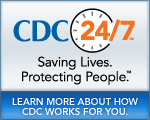Emerging Infectious Diseases Journal
Highlights: EID, Vol. 17, No. 5 (May 2011)
Disclaimer
The articles summarized below will appear in the May 2011 issue of Emerging Infectious Diseases, CDC's monthly peer-reviewed public health journal. This issue will feature vector-borne infections. The articles are embargoed until April 13, 2011, at 12 p.m. EDT.
Note: The EID Journal publishes articles by scientists around the world, as well as CDC scientists. To correctly describe CDC's role, please clarify in your story whether a study was conducted by CDC or was conducted by the author's institution and published in CDC's Emerging Infectious Diseases journal.
1. Vector-Borne Infections
Ronald Rosenberg and C. Ben Beard
Vectors, such as mosquitoes and ticks, are a major source of emerging infections. Vectors are numerous and able to carry almost every type of infectious agent (such as viruses or bacteria). They can spread disease to new areas or to new species that otherwise would never come in contact with each other. Prevention is difficult because vaccines are available for only a few of these diseases. Control is also difficult because infectious agents and vectors are extremely adaptable and can evolve to avoid public health efforts. Changes in climate, land use, and transportation add to the challenges posed by emerging vector-borne infections.
Contact Dr. Ronald Rosenberg via:
CDC Press Office
404-639-3286
media@cdc.gov
2. Increasing Trend in Hospitalizations for Dengue, USA
Judy A. Streit, et al.
Once limited to the tropics, dengue activity worldwide is at an all time high and dengue reemerged in Florida in 2009 after being absent for 45 years. During the past decade, the number of people hospitalized with dengue infections in the United States has tripled, probably because of increased travel to the tropics and the spread of the mosquitoes that carry dengue virus, which are now present in more than half of U.S. states. To better track this trend, since 2010, doctors nationwide have been required to report cases of dengue fever to public health authorities.
Contact:
Philip M. Polgreen
University of Iowa, Carver College of Medicinea€“Internal Medicine, Division of Infectious Diseases
319-356-7740
philip-polgreen@uiowa.edu
3. Babesiosis in the Lower Hudson Valley Region, New York, USA
Julie T. Joseph, et al.
Babesiosis, a potentially deadly disease, is emerging in the Lower Hudson Valley, just north of New York City. The disease is caused by a parasite that destroys red blood cells. Since first appearing in the Lower Hudson Valley in 2001, babesiosis cases have increased 12 times faster in the this area than in the rest of the state. Cases are occurring mostly in residents who were bitten by ticks or had been treated with blood products. The risk is highest for people with weakened immune systems.
Contact:
Julie T. Joseph, M.D.
New York Medical College, Division of Infectious Diseases
julie_joseph@nymc.edu
4. Evidence of Tungiasis in Pre-Hispanic America
Vicente Maco, et al.
Tungiasis is a skin disease caused by a flea, the smallest in the world. This flea burrows into the skin and causes intense pain and itching. Recently, tungiasis has been increasing among residents of the tropics and those who visit there. The past of this disease is as intriguing as any future public health challenges it may pose. Texts from 1615 through 1990 led researchers to four pottery artifacts from ancient Peru, which depict people with tungiasis. Pottery fragments show characteristic holes in the soles of the feet, and in some, the affected persons are trying to remove the fleas from these holes. The artifacts indicate that tungiasis has been in Peru for at least 14 centuries.
Contact:
Vicente Maco MD, Associate Investigator
Institute of Tropical Medicine Alexander von Humboldt, Lima, Peru
Beth Israel Medical Center, Infectious Diseases Department, New York
443-939-7007
vicente_maco@hotmail.com
The opinions expressed by authors contributing to this journal do not necessarily reflect the opinions of the U.S. Department of Health and Human Services, the Public Health Service, the Centers for Disease Control and Prevention, or the authors' affiliated institutions. Use of trade names is for identification only and does not imply endorsement by any of the groups named above.
- Historical Document: April 13, 2011
- Content source: Office of the Associate Director for Communication, Division of News and Electronic Media
- Notice: Linking to a non-federal site does not constitute an endorsement by HHS, CDC or any of its employees of the sponsors or the information and products presented on the site.
View Press Releases in
Get e-mail updates
To receive e-mail updates about this page, enter your
e-mail address:
Contact Us:
- Centers for Disease Control and Prevention
1600 Clifton Rd
Atlanta, GA 30333 - 800-CDC-INFO
(800-232-4636)
TTY: (888) 232-6348 - Contact CDC-INFO


